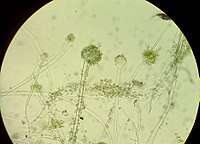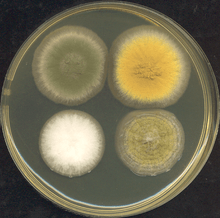Aspergillus oryzae
Aspergillus oryzae, also known as kōji mold (Japanese: ニホンコウジカビ (日本麹菌), Hepburn: nihon kōji kabi), is a filamentous fungus (a mold) used in Japan to saccharify rice, sweet potato, and barley in the making of alcoholic beverages such as sake and shōchū, and also to ferment soybeans for making soy sauce and miso. However, in the production of fermented foods of soybeans such as soy sauce and miso, Aspergillus sojae is mainly used instead of A. oryzae.[2][3] A. oryzae is also used for the production of rice vinegars. Barley kōji (麦麹) or rice koji (米麹) are made by fermenting the grains with A. oryzae hyphae.[4]
| Aspergillus oryzae | |
|---|---|
.jpg) | |
| A. oryzae growing on rice to make koji | |
| Scientific classification | |
| Kingdom: | Fungi |
| Division: | Ascomycota |
| Class: | Eurotiomycetes |
| Order: | Eurotiales |
| Family: | Trichocomaceae |
| Genus: | Aspergillus |
| Species: | A. oryzae |
| Binomial name | |
| Aspergillus oryzae (Ahlburg) E. Cohn[1] | |
Eiji Ichishima of Tohoku University called the kōji fungus a "national fungus" (kokkin) in the journal of the Brewing Society of Japan, because of its importance not only for making the kōji for sake brewing, but also for making the kōji for miso, soy sauce, and a range of other traditional Japanese foods. His proposal was approved at the society's annual meeting in 2006.[5]
The Japanese word kōji (麹) is used in several meanings, and in some cases it specifically refers to A. oryzae, while in other cases it refers to all molds used in fermented foods, including Monascus purpureus and other molds, so care should be taken to avoid confusion.[6]
Properties desirable in sake brewing and testing
The following properties of A. oryzae strains are important in rice saccharification for sake brewing:[7]
- Growth: rapid mycelial growth on and into the rice kernels
- Enzymes: strong secretion of amylases (α-amylase and glucoamylase); some carboxypeptidase; low tyrosinase
- Aesthetics: pleasant fragrance; accumulation of flavoring compounds
- Color: low production of deferriferrichrome (a siderophore), flavins, and other colored substances
Varieties used for shōchū making
Three varieties of kōji mold are used for making shōchū, each with distinct characteristics.[8][9][10]
Genichirō Kawachi (1883 -1948), who is said to be the father of modern shōchu and Tamaki Inui (1873 -1946), a lecturer at University of Tokyo succeeded in the first isolating and culturing aspergillus such as A. kawachii, A. awamori and a variety of subtaxa of A. oryzae, which made great progress in producing shochu in Japan, and since then aspergillus developed by Kawachi has also been used for soju and makgeolli in Korea.[11][12][13]
- Yellow kōji (A. oryzae etc) is used to produce sake, and at one time all honkaku shōchū. However, yellow kōji is extremely sensitive to temperature; its moromi can easily sour during fermentation. This makes it difficult to use in warmer regions such as Kyūshū, and gradually black and white kōji became more common in production of shōchū. Its strength is that it gives rise to a rich, fruity, refreshing taste, so despite the difficulties and great skill required, it is still used by some manufacturers. It is popular amongst young people who previously had no interest in typically strong potato shōchū, playing a role in its recent revival. Thus, white and black kōji are mainly used in the production of shōchū, but only yellow kōji (A. oryzae) is usually used in the production of sake.
- White kōji (A. kawachii etc) was discovered as a mutation from black kōji by Genichirō Kawachi in 1923.[11] This effect was researched and white kōji was successfully grown independently. White kōji is easy to cultivate and its enzymes promote rapid saccharization; as a result, it is used to produce most shōchū today. It gives rise to a drink with a refreshing, mild, sweet taste.
- Black kōji (A. awamori also known as A. luchuensis etc) is mainly used to produce shōchū and awamori. In 1901, Tamaki Inui, lecturer at University of Tokyo succeeded in the first isolating and culturing. In 1910, Genichirō Kawachi succeeded for the first time in culturing var. kawachi, a variety of subtaxa of A. awamori. This improved the efficiency of shochu production.[11] It produces plenty of citric acid which helps to prevent the souring of the moromi. Of all three kōji, it most effectively extracts the taste and character of the base ingredients, giving its shōchū a rich aroma with a slightly sweet, mellow taste. Its spores disperse easily, covering production facilities and workers' clothes in a layer of black. Such issues led to it falling out of favour, but due to the development of new kuro-kōji (NK-kōji) in the mid-1980s,[14] interest in black kōji resurged amongst honkaku shōchū makers because of the depth and quality of the taste it produced. Several popular brands now explicitly state they use black kōji on their labels.
Genome
Initially kept secret, the A. oryzae genome was released by a consortium of Japanese biotechnology companies[15] in late 2005.[16] The eight chromosomes together comprise 37 million base pairs and 12 thousand predicted genes. The genome of A. oryzae is thus one-third larger than that of two related Aspergillus species, the genetics model organism A. nidulans and the potentially dangerous A. fumigatus.[17] Many of the extra genes present in A. oryzae are predicted to be involved in secondary metabolism. The sequenced strain isolated in 1950 is called RIB40 or ATCC 42149; its morphology, growth, and enzyme production are typical of strains used for sake brewing.[18]
Use in biotechnology
Trans-resveratrol can be efficiently cleaved from its glucoside piceid through the process of fermentation by A. oryzae.[19]
History of kōji in a broad sense
麹 (chinese qū, japanese kōji) which means mold used in fermented foods, was first mentioned in the Zhouli (Rites of the Zhou dynasty) in China in 300 BCE. Its development is a milestone in Chinese food technology, for it provides the conceptual framework for three major fermented soy foods: soy sauce, jiang / miso, and douchi, not to mention grain-based wines (including Japanese sake and Chinese huangjiu) and li (the Chinese forerunner of Japanese amazake).[20][18]
Gallery
 Conidiophores with conidia of the microscopic fungus A. oryzae under light microscope
Conidiophores with conidia of the microscopic fungus A. oryzae under light microscope Four Aspergillus colonies grown at 37°C for three days on rich media: The bottom two are A. oryzae strains.
Four Aspergillus colonies grown at 37°C for three days on rich media: The bottom two are A. oryzae strains.
See also
- Qū
- Akira Endo
- Aspergillus sojae
- Lactase
- Medicinal molds
- Rhizopus oligosporus
References
- Index Fungorum
- しょうゆづくりの歩みと麹菌の関わり Kenichiro Matsushima
- 麹菌ゲノム解読 Kikkoman
- Parmjit S. Panesar, Biotechnology in Agriculture and Food Processing: Opportunities and Challenges CRC Press (2014)
- Fujita, Chieko, Tokyo Foundation Koji, an Aspergillus Archived 2009-05-22 at the Wayback Machine
- 麹のこと Marukome
- Kitamoto, Katsuhiko (2002). Molecular Biology of the Koji Molds. Advances in Applied Microbiology. 51. pp. 129–153. doi:10.1016/S0065-2164(02)51004-2. ISBN 9780120026531. PMID 12236056. Retrieved 2008-01-03.
- "In-depth". Retrieved 2007-01-24. (Japanese)
- "What is Shochu?". Archived from the original on 2007-09-28. Retrieved 2007-01-24.
- "Other terminology relating to Shochu and Awamori". Retrieved 2007-01-27. (Japanese)
- 初代 河内源一郎(1883~1948) Kawauchi-kin honpo
- 元祖 源一郎さんの生マッコリ
- <8>黒麹菌の役割 発酵中の雑菌繁殖防ぐ Okinawa times
- "Shochu Circle". Retrieved 2007-12-11.
- Goffeau, André (December 2005). "Multiple moulds". Nature. 438 (7071): 1092–1093. doi:10.1038/4381092b. PMID 16371993.
- Machida, Masayuki; et al. (December 2005). "Genome sequencing and analysis of Aspergillus oryzae". Nature. 438 (7071): 1157–1161. doi:10.1038/nature04300. PMID 16372010.
- Galagan JE, et al. (December 2005). "Sequencing of Aspergillus nidulans and comparative analysis with A. fumigatus and A. oryzae". Nature. 438 (7071): 1105–1115. doi:10.1038/nature04341. PMID 16372000.
- Rokas, A. (2009). "The effect of domestication on the fungal proteome". Trends in Genetics. 25 (2): 60–63. doi:10.1016/j.tig.2008.11.003. PMID 19081651.
- Wang, H.; Liu, L.; Guo, Y. -X.; Dong, Y. -S.; Zhang, D. -J.; Xiu, Z. -L. (2007). "Biotransformation of piceid in Polygonum cuspidatum to resveratrol by Aspergillus oryzae". Applied Microbiology and Biotechnology. 75 (4): 763–768. doi:10.1007/s00253-007-0874-3. PMID 17333175.
- Shurtleff, W.; Aoyagi, A. History of Koji - Grains and/or Soybeans Enrobed with a Mold Culture (300 BCE to 2012). Lafayette, California: Soyinfo Center. 660 pp. (1,560 references; 142 photos and illustrations, Free online)
External links
- Making Rice Koji from Koji Spores
- Sake World's description of koji
- Aspergillus oryzae genome from the Database of Genomes Analysed at NITE (DOGAN)